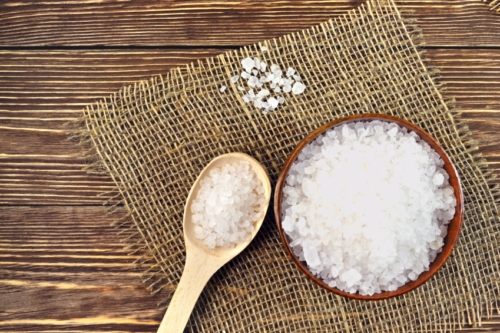 A salt water flush is a way to help cleanse your colon of all of the waste that has yet to be removed from it, or to remove material that isn’t moving on its own fast enough.
A salt water flush is a way to help cleanse your colon of all of the waste that has yet to be removed from it, or to remove material that isn’t moving on its own fast enough.
The typical North American diet leads to many people suffering from constipation and troubled bowel movements. This can be fixed by eating more leafy green vegetables and fiber for added roughage, but a salt water flush can assist that process as well. A salt water flush can benefit those who suffer from troubled bowl movements, or worse, no bowel movements at all.
If you have high blood pressure, please consult a doctor before doing a salt water flush as salt does cause spikes in blood pressure readings and can be dangerous for some.
What Is a Salt Water Flush?
A salt water flush is another form of a colon cleanse. It’s sometimes called a “salt water cleanse” as well. Enemas are the more common type of colon cleanse, but they are invasive and costly, so they’re not a practical solution for many people; plus they’re typically done in preparation for a colonoscopy. A salt water flush is an easy cleanse that can be done at home using ingredients you will find already stored in the pantry.
The idea of a salt water flush is to force a bowel movement so the colon and digestive system can be cleansed of the junk that is lingering in there. The salt water flush is part of an overall cleanse program called the Master Cleanse, which has been endorsed by many celebrities. In the Master Cleanse, all that is consumed is a lemonade type drink, a salt water drink, and a laxative tea, but the salt water cleanse can also be done on its own without the other fluids.
To do a salt water flush, be sure to have not eaten for at least one hour before you drink the mixture. Take one liter of water and add two teaspoons of good quality sea salt (Himalayan is best) and stir (or shake if in a sealed container) until the salt has thoroughly dissolved. Drink the mixture in one shot as fast as you can, then lie down on your side for 30 minutes. After that time, the effects will start to kick in and will continue for a few hours—you will be having bowel movements often, so it’s best to not make plans for the day. The first movement will come with great intensity; the others less so as more waste is removed from your system.
Health Benefits of a Salt Water Flush
A salt water flush does have many health benefits associated with it, but the first immediate benefit is that you’ll lose a few pounds, and your colon and digestive system will be cleaned up. Approximately 85% of Americans suffer from some kind of digestive issue, whether it’s troubled elimination or poor digestion. Some of the benefits of a salt water cleanse include:
- Helps ease sore throats
- Cleans wounds
- Cleans the colon and removes toxins
- Balances electrolyte and mineral levels in the body
- Eases fluid retention
- Hormonal balance
- Balances the pH level in the body by making it more alkaline
- Provides the body with trace minerals
- Can decrease pain in inflamed joints and muscles
- Optimizes the digestion process
Is a Salt Water Flush Dangerous?
There aren’t many salt water flush dangers, but caution needs to be taken when performing the flush. Some uncomfortable side effects of a salt water flush include vomiting, nausea, and weakness. If you have high blood pressure or digestive issues, please seek the advice of a doctor before doing the flush just to be safe.
Sources for Today’s Article:
“The Salt Water Flush,” The Master Cleanse web site;
http://themastercleanse.org/salt-water-flush/, last accessed March 3, 2016.
“How to Perform a Salt Water Flush to Cleanse Your Colon,” Real Foods Witch web site;
http://realfoodswitch.com/detox/perform-salt-water-flush-cleanse-colon/, last accessed March 3, 2016.
“Detox with an Easy Salt Water Flush,” Easy Health Options web site; http://easyhealthoptions.com/detox-with-an-easy-salt-water-flush/, last accessed March 3, 2016.
